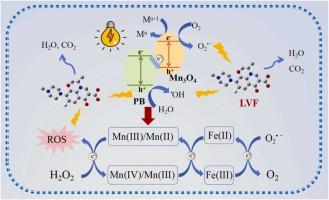Photo-Fenton enhanced self-floating Z-scheme Prussian blue/Mn3O4 heterojunction for efficient levofloxacin degradation: Mechanism, pathway and DFT analysis
IF 5.4
2区 化学
Q2 CHEMISTRY, PHYSICAL
Colloids and Surfaces A: Physicochemical and Engineering Aspects
Pub Date : 2025-10-11
DOI:10.1016/j.colsurfa.2025.138653
引用次数: 0
Abstract
This study constructed a Z-scheme p-n heterojunction (M-PB) using n-type Prussian blue (PB) and p-type Mn3O4, immobilized on cellulose aerogel (M-PB-AG), for levofloxacin (LVF) degradation via photo-Fenton technology. Optical and electrochemical characterization confirmed the successful Z-scheme heterojunction formation, with optimized band alignment enabling efficient electron transfer from PB to Mn3O4 while suppressing charge recombination. The experimental results demonstrated a strong synergistic effect between Mn3O4 and PB (74.2 %), photocatalysis (Vis) and the Fenton reaction (H2O2) (65.8 %). In Vis/H2O2/M-PB-AG system at pH = 5, M-PB-AG achieve 93.9 % LVF degradation in 60 min. The Vis/H2O2/M-PB-AG system degraded LVF mainly via non-radical 1O2, with additional h+/e− and O2•− contributions. Fe/Mn valence cycling enabled continuous reactive oxygen species (ROS) generation, maintaining 80.1 % efficiency after 5 cycles. Continuous flow experiments confirmed practical application potential. The process remained effective regardless of pH, ions, organics, or oxygen. DFT and LC-MS revealed degradation pathways and product toxicity. This work provides new insights for developing efficient photocatalysts for water treatment.

光- fenton增强自漂浮Z-scheme普鲁士蓝/Mn3O4异质结高效降解左氧氟沙星:机理、途径和DFT分析
本研究以n型普鲁士蓝(PB)和p型Mn3O4为材料,在纤维素气凝胶(M-PB- ag)上固定化,构建了z型p-n异质结(M-PB),用于光- fenton技术降解左氧氟沙星(LVF)。光学和电化学表征证实了Z-scheme异质结的成功形成,优化的能带对准使电子从PB向Mn3O4有效转移,同时抑制了电荷重组。实验结果表明,Mn3O4与PB(74.2 %)、光催化(Vis)和Fenton反应(H2O2)(65.8% %)之间具有较强的协同效应。在pH = 5的Vis/H2O2/M-PB-AG体系中,M-PB-AG在60 min内对LVF的降解率达到93.9 %。Vis/H2O2/M-PB-AG体系主要通过非自由基1O2降解LVF,并有额外的h+/e−和O2•−贡献。Fe/Mn价循环使活性氧(ROS)持续生成,5次循环后效率保持在80.1 %。连续流动实验证实了实际应用潜力。无论pH值、离子、有机物或氧气如何,这个过程都是有效的。DFT和LC-MS揭示了降解途径和产物毒性。这项工作为开发高效的水处理光催化剂提供了新的思路。
本文章由计算机程序翻译,如有差异,请以英文原文为准。
求助全文
约1分钟内获得全文
求助全文
来源期刊
CiteScore
8.70
自引率
9.60%
发文量
2421
审稿时长
56 days
期刊介绍:
Colloids and Surfaces A: Physicochemical and Engineering Aspects is an international journal devoted to the science underlying applications of colloids and interfacial phenomena.
The journal aims at publishing high quality research papers featuring new materials or new insights into the role of colloid and interface science in (for example) food, energy, minerals processing, pharmaceuticals or the environment.

 求助内容:
求助内容: 应助结果提醒方式:
应助结果提醒方式:


